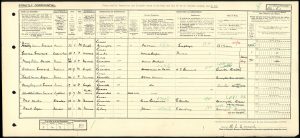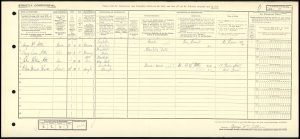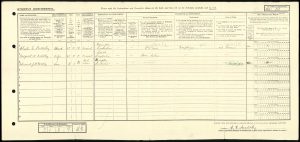The 1921 census and its insight into rural life
- 27th August 2025
In our latest blog about the 1921 census, the story of Alvie’s family gives a fascinating insight into life in rural Lincolnshire.
Both sides of my family have lived in rural Lincolnshire for centuries. In 1921 most of my relatives were living around the villages of Benington and Leverton in South Lincolnshire, which is about 5-7 miles outside of the market town of Boston, and on the road heading towards Skegness.
Both my grandparents on my mum’s side of the family were born in the late 1920s therefore I needed to look for my great grandparents who were all unmarried at the time of the census. My grandad’s parents were in their 20s; Frank Foster was 26 years old and working as a farm worker for a local farmer called William Neal. I know from conversations with my parents that he later became the barber in the village, although the selection of hairstyles he offered was very limited! Frank was living or staying in the household of his brother Peter, who was a blacksmith, when the census took place. The brother’s had moved from the town of Horncastle in Lincolnshire. In 1925 Frank would marry Lavinia Toynton, who had been 20 years old when the census took place. Lavinia was living with her parents and helping with the domestic labour; her father was a farm worker, but he clarified on the census that his primary job was as a hedger and ditcher.
My grandma’s parents were also on the census but like my other great grandparents they were yet to get married. William Everard was 22 years old and a horseman on his uncle’s farm. This meant that he looked after and worked with the horses who did some of the farm work, such as ploughing. Most farmers still used heavy horse breeds, such as Shire Horses, to work on the land in the early decades of the twentieth century. Later William would become a farmer in his own right.

William Everard in the 1921 census © Crown Copyright
Elsie Woods, my great grandma, was the daughter of another local farmer. She was only 15 years and 10 months old at the time of the census and having left school she had gone to work as a nurse maid for a grocer. The grocer, George Atkin, and his wife had a 10-month-old son at the time of the census. As the Atkins lived in Manchester, Elsie was definitely not where I expected her to be! My Mum has since told me that Elsie had helped to teach Sunday School for several years and it was on the Vicar’s recommendation that she went to work as a nurse maid. The census shows that George Atkins was originally from the Boston area which explains his connection to the Vicar. Having grown up in the same rural area as my other family members Elsie must have experienced quite the culture shock when moving to a large city on her own at such a young age. Elsie moved back to Lincolnshire once her childcare services were no longer needed. In 1925 Elsie married my great grandad, William Everard.

The entry relating to the Atkins family in the 1921 census © Crown Copyright
On my dad’s side of the family my grandparents are both on the census as their parents were older, but they are both small children. My grandad was 5 years old, and my grandma was 2 years old. My grandad would grow up to become the butcher in Benington. Looking back through the family tree my ‘Maltby’ family were mostly butchers and/or farmers in rural Lincolnshire as far back as the 16th century, so my grandad followed in the footsteps of many of his ancestors. His father, my great-grandad Charles Edmund Maltby was a farmer, owning a farm in Sea End, Benington at the time of the census. We do not have any photos from that year however below is a photo of Charles Edmund Maltby, his wife Margaret and my grandad when he was only a few months old in 1916.

An entry relating to the Maltby family taken from the 1921 census © Crown Copyright

A family photograph taken by the Maltby family.
My grandma Fanny Emma Mary Bolland grew up on Sea End Farm, Benington. By the time of the census her parents, who were in both in their 30s, already had 7 children, including my grandma, who was born in 1918. In total the Bolland family would have 12 living children.
The 1921 census shows us a snapshot of rural life before the huge changes which happened in farming during the 20th century. The widespread introduction of heavier machinery and pesticides following WWII reduced the numbers of farm labourers required to run farms and impacted the profitability of smallholdings. This led many to move away from rural areas and the farming industry. In my family, my great-grandparents were the last generation to live this rural way of life and work in these traditional industries; none of my family on either side now live in those villages which had been home for generations.
Post a Comment